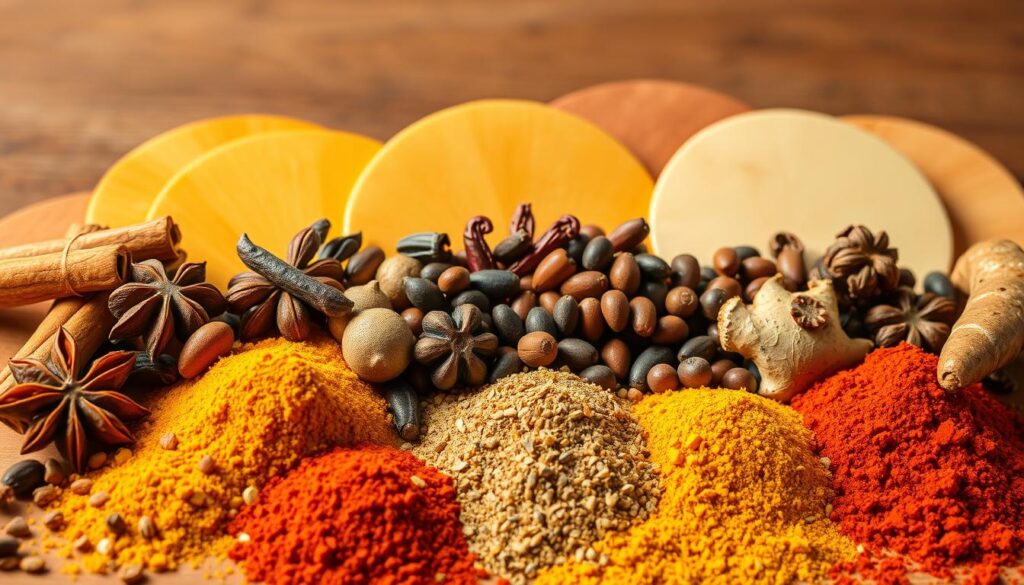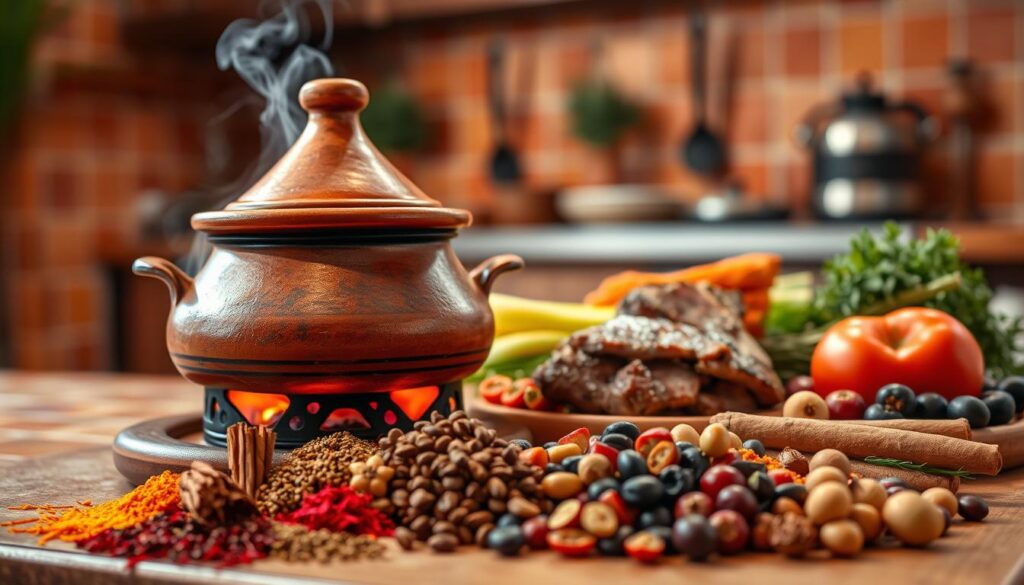Moroccan Food You Must Try – Top 10 Dishes to Eat in Morocco
Table of Contents
Moroccan Food
Did you know some recipes savoured in Moroccan kitchens today trace their roots back over 2,700 years? This culinary tradition, shaped by centuries of cultural exchange, uses spices like saffron and cumin in ways that’ll make your taste buds dance. Imagine flavours perfected through generations of Arab, Berber, and Mediterranean influences – each dish tells a story older than most nations.
You’ll discover how simple ingredients like slow-cooked meats, seasonal vegetables, and hand-rolled couscous transform into vibrant masterpieces. From bustling Marrakech markets to family-run eateries in Fez, every bite reflects a blend of history and hospitality. Even the clay pots used for cooking – called tagines – play a starring role in creating those rich, aromatic stews.
What makes this cuisine truly special? It’s the balance of sweet and savoury, achieved through techniques passed down since the 7th century BC. Think tender lamb paired with dried fruits, or fluffy semolina grains steamed to perfection. We’ll guide you through the essentials, ensuring you know exactly which dishes to seek (and what makes them unforgettable).
Key Takeaways
- Discover a culinary legacy shaped by Arab, Berber, and Mediterranean traditions
- Learn how spices like cumin and saffron create signature flavour profiles
- Explore dishes with histories stretching back over two millennia
- Identify must-try specialities from street food to celebratory feasts
- Understand the cultural significance behind cooking methods like tagine simmering
Introduction to Moroccan Food
Imagine a culinary tapestry woven from centuries of cultural exchange. This region’s signature dishes blend sweet dates with savoury lamb, cinnamon with earthy cumin, creating harmonies that surprise even seasoned travellers. Every bite tells stories of ancient trade routes and shared traditions.
What Makes This Cuisine Unique?
You’ll find masterful contrasts in textures and flavours. Crisp pastry layers hide tender spiced poultry in pastilla, while slow-cooked tagines meld dried fruits with aromatic meats. It’s this balance – perfected over generations – that sets the food apart from neighbouring culinary traditions.
Embracing Tradition and Innovation
Modern chefs honour time-tested methods like clay-pot simmering, but add artistic plating twists. Seasonal ingredients keep recipes vibrant – think saffron-infused autumn stews or springtime herb salads. Shared platters remain central, turning meals into lively gatherings where stories flow as freely as mint tea.
A Rich History of Moroccan Culinary Traditions
Picture this: a 9th-century spice caravan winding through the Atlas Mountains, its treasures destined for Fes’ fledgling markets. When the Idrissid dynasty established this city in 789 CE, they unwittingly created a melting pot where Arab ingredients met Berber recipe traditions. This fusion birthed a culinary identity that’s still celebrated in kitchens today.
Influences from Arab, Berber and Mediterranean Cultures
Arab traders introduced saffron, ginger and intricate pastry techniques, while local communities contributed slow-cooked stews and communal dining customs. You’ll notice this blend in iconic dishes – think flaky pastilla pies layered with centuries of know-how.
Trade routes didn’t just bring foreign spices. Clever adaptation turned imports into local specialities. Take Talaouine’s saffron fields: originally Persian seeds, now yielding some of the world’s most sought-after threads. Similarly, Meknès’ olive groves and Fes’ citrus orchards became self-sufficient flavour hubs.
Mediterranean neighbours left their mark through preservation methods. Those zesty preserved lemons brightening your tagine? They’re a direct result of coastal food storage practices meeting North African creativity.
Through every cultural shift, one constant remains: the Berber emphasis on shared meals and patient cooking. It’s why every recipe feels like an invitation to gather, savour and connect – just as generations have done before.
Key Ingredients and Spices for Authentic Dishes
Behind every unforgettable meal lies a carefully curated palette of flavours. The alchemy begins with understanding which elements build depth, balance, and that signature warmth. Let’s explore the building blocks that turn simple components into complex masterpieces.

Ras el Hanout and Preserved Lemons
Ras el hanout – meaning ‘top of the shop’ – lives up to its name. This spice blend combines up to twenty-seven ingredients, from cinnamon to ginger, creating an earthy yet floral backbone for stews and rubs. Artisan vendors often guard their recipes like family heirlooms.
Preserved lemon offers a brighter counterpoint. Fermented with just salt and time, its zesty punch cuts through rich meats. You’ll find slivers elevating tagines or minced into vibrant salad dressings.
Herbs and Other Essential Flavours
Fresh herbs provide crucial contrast. Mint cuts through sweetness in teas, while coriander lifts slow-cooked dishes. Dried saffron threads from Talaouine lend golden hues and subtle floral notes.
Stock your pantry wisely: whole cumin seeds retain aroma longer than pre-ground versions. Toasted sesame seeds add crunch, whilst spices like paprika build layered heat. Remember – freshness matters more than quantity.
The Magic of the Tagine
Ever wondered how a simple clay pot became North Africa’s ultimate flavour amplifier? The secret lies in its iconic conical lid, designed to trap and recycle steam like nature’s own sous-vide machine. This ingenious design turns tough cuts into melt-in-your-mouth marvels while intensifying spices into rich, aromatic sauces.

Slow-Cooked Perfection
When you simmer lamb or chicken in a tagine, something magical happens. Collagen breaks down slowly, transforming sinewy meat into tender morsels that soak up saffron and cumin like flavour sponges. Even root vegetables emerge velvety yet intact – a textural ballet ordinary pots can’t replicate.
Don’t own the traditional cookware? No worries. A heavy casserole dish with a tight lid works wonders. As one Marrakech chef puts it: “The technique matters more than the tool – low heat and patience are your true ingredients.”
| Aspect | Tagine Cooking | Conventional Pot |
|---|---|---|
| Moisture Retention | Self-basting steam cycle | Frequent stirring needed |
| Cooking Time | 3-4 hours (ideal for lamb) | 1-2 hours (risk of dryness) |
| Flavour Concentration | Intense, layered tastes | More diluted results |
The classic recipe starring olives and preserved lemons demonstrates this beautifully. Juicy chicken thighs bathe in tangy citrus brine, while green olives add salty contrast. It’s all about building flavours in stages – onions first, spices next, proteins last.
Master the art of minimal liquid. Start with just half a cup of stock – the closed environment does the rest. You’ll be amazed how apricots plump and spices bloom when given time to work their magic. Perfect for Sunday roasts or impressing dinner guests!
Couscous – The Heart of Moroccan Meals
Friday afternoons in Morocco smell of steaming semolina and simmering broth. At the centre of this weekly ritual lies couscous – not just a dish, but a cultural institution passed through generations. Families gather around communal platters, sharing stories as much as sustenance.
Family Traditions and Hearty Preparations
Authentic preparation demands patience. The grains undergo three steamings in a special pot called a kiska, fluffed by hand between each session. This labour-intensive process creates the light, airy texture that perfectly absorbs rich broths.
Modern cooks often use pre-steamed varieties, but the essence remains. As one Fez grandmother explains: “It’s not about shortcuts – it’s about taking time to nourish those you love.”
| Aspect | Traditional Method | Modern Approach |
|---|---|---|
| Grains | Hand-rolled semolina | Pre-steamed packets |
| Cooking Time | 2-3 hours | 15 minutes |
| Vegetables | Seasonal garden picks | Supermarket selections |
The classic presentation remains unchanged – a golden mound of couscous surrounded by tender lamb and seven colourful veggies. Carrots and courgettes nestle against sweet pumpkin, each absorbing the spiced broth poured tableside.
Timing proves crucial. The meat must braise until falling apart just as the final steam finishes. When done right, this meal becomes edible harmony – each element enhancing the others through careful preparation and shared intention.
Moroccan food: A Fusion of Flavours
Have you ever tasted a dish where cinnamon dances with saffron? This culinary tradition thrives on bold contrasts that surprise and delight. Think tender lamb nestled against honey-glazed apricots, or flaky pastry hiding spiced poultry dusted with icing sugar.
Sweet and Savoury Combinations
The magic lies in measured pairings. Dried fruits rehydrate in rich stews, their natural sugars balancing earthy ras el hanout. Toasted almonds add crunch to tender tagines, while orange blossom water whispers through savoury stuffings.
Take pastilla – crisp warqa pastry embraces cinnamon-dusted pigeon. A dusting of icing sugar completes this iconic moroccan spiced creation. It’s this fearless blending that makes each bite an adventure.
Spices That Bring Dishes to Life
Mastering spices means understanding their personalities. Cumin grounds, cardamom intrigues, while turmeric paints golden hues. The secret? Layering them like musical notes.
| Stage | Spice Group | Effect |
|---|---|---|
| Base | Cumin, paprika | Builds depth |
| Mid-cook | Ginger, cinnamon | Adds warmth |
| Finish | Saffron, cardamom | Elevates aroma |
Bloom whole spices in oil first to unlock their oils. Add delicate ones like saffron later to preserve floral notes. As one Marrakech cook advises: “Treat each like a guest – know when to make them shine.”
Whether tweaking a moroccan spiced rub or balancing ingredients, trust your palate. The best dish? One that keeps you reaching for another bite, curious about every layered flavour.
Top 10 Must-Try Dishes in Morocco
Your culinary adventure reaches its peak with these iconic creations. Each recipe showcases generations of kitchen wisdom, transforming humble ingredients into flavour symphonies you’ll crave long after your last bite.
Chicken Tagine with Olives and Preserved Lemon
Succulent chicken thighs simmered with briny olives and zesty lemon define comfort cooking. The magic lies in the marinade – ras el hanout spices seep into every fibre during slow cooking. Perfect with crusty bread for scooping up that fragrant sauce.
Lamb Shank Tagine and More
Fall-off-the-bone lamb shanks star in this Marrakech speciality. Garlic and preserved lemon cut through the richness, while apricots add natural sweetness. Don’t miss pastilla’s crisp pastry embracing spiced poultry, or tanjia’s intense flavours from hammam-fire cooking.
Whether you’re recreating these recipes at home or savouring them street-side, each dish offers a delicious lesson in cultural heritage. From first bite to last crumb, you’re tasting history served with heart.







